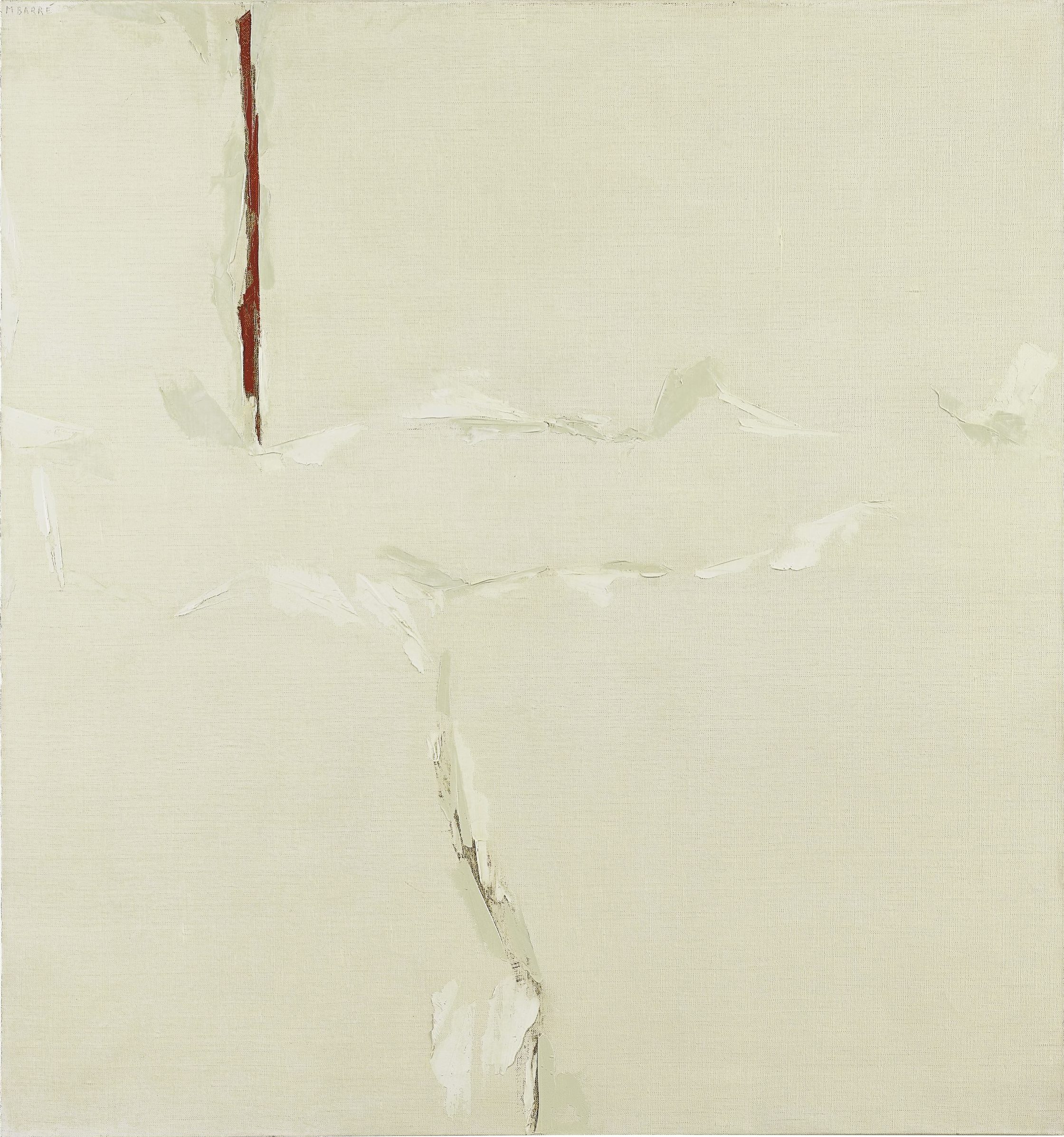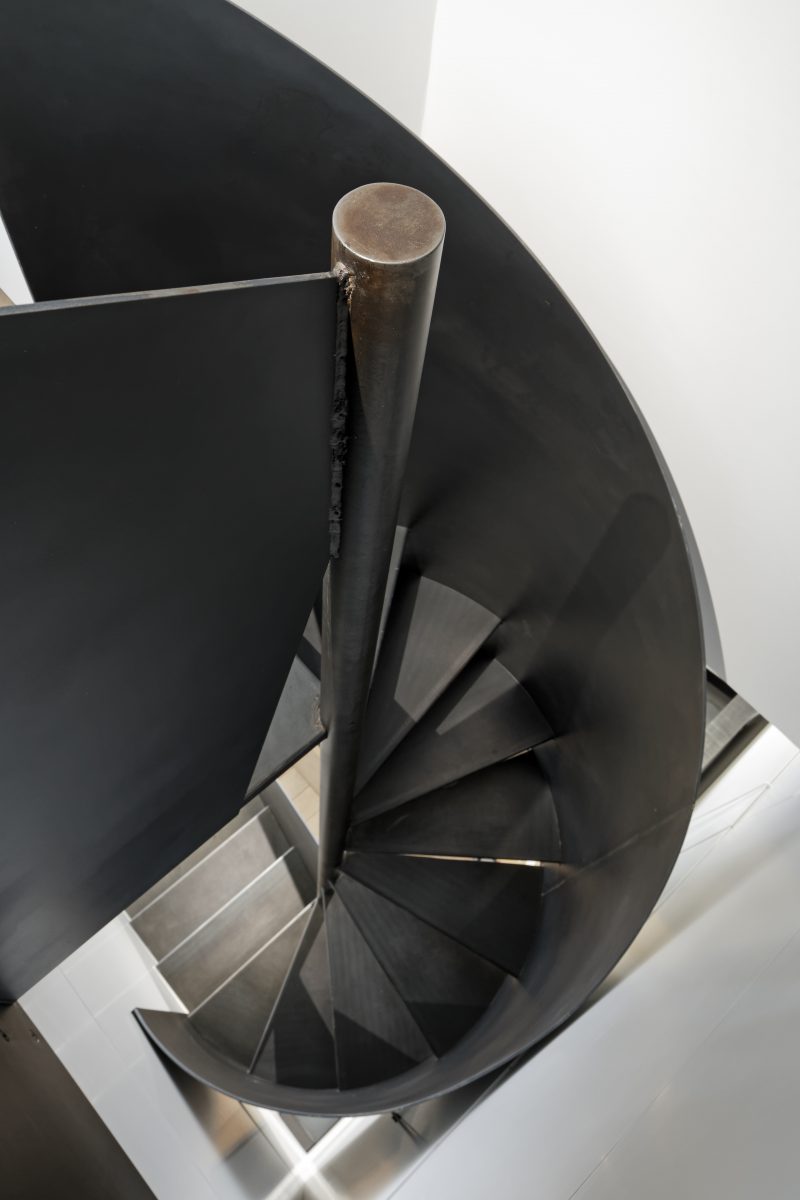In 1957, the Arnaud Gallery held a third solo exhibition of Barré’s work. The pictures were painted with a knife and dominated by meticulously -worked whites ranging “from blinding to velvety” (Ragon). Mobile embedded shapes appeared, particularly as a result of the prominence given to the backing revealed by scratching the canvas with framing rods. Black played an important part in a palette based on sienna and subtle touches of Naples yellow. Following his visits to Holland, where he studied Rembrandt, Hals, Vermeer and Malevich with absorption, then Spain, where he became fascinated by Greco and Vélasquez, Barré’s touch became more gestural.
He exhibited at the Arnaud Gallery again in 1959. In May, he showed meticulous gouaches with reserved areas that gave full weight to the white of the paper, and in November, white and black paintings. Barré said of these monochromatic paintings, which were criticised by some: “My white period (in 1959), which the first viewers probably saw as non-coloured, is in fact quite the reverse. In my work, it represents the advent of colour, because colour takes over from form and ground. Colour becomes space.” (Interviews with Michel Ragon, cited in Vingt-cinq ans d’Art vivant, Galilée, 1986)
In 1960, he returned to oils, tracing lines by applying tubes of paint directly to the surface, which created the sensation that the space defined by this imprint extended beyond the frame. Michel Ragon published his monograph Martin Barré ou la poétique de l’espace, published by Arnaud.
The Arnaud Gallery held exhibitions of his work in 1960, 1962, 1964, 1967 and 1968. He then embarked on a more Baroque type of painting.
Barré never ceased to explore, constantly questioning his earlier achievements. As he saw it, his pictures “open directly onto the world we live in and it are best seen as reflecting the human milieu as it should be or ought to become.”
Barré took part in many group exhibitions in France and abroad, including:
1955: “Dix-sept Peintres de la Génération nouvelle”, Kléber Gallery, Paris.
1956
“L’Aventure de l’Art abstrait”, Arnaud Gallery, Paris and Festival de l’art d’avant-garde, Cité Radieuse (designed by Le Corbusier), Marseille
“Cinquante ans de peinture abstraite”, Creuze Gallery, Paris
“Jeunes Peintres” (Barré, Guitet, G. Resse) and “Eloge du petit format II”, La Roue Gallery.
1956-1957: “Pentagone”, Arnaud Gallery.
1957
“gouaches et collages”, Le Gendre Gallery
Festival de l’art d’avant-garde, Cité Radieuse, Rezé-lès-Nantes
“Nouvelle Ecole de Paris”, Bridgestone Gallery, Tokyo.
1958
“Sixteen Painters of the École de Paris”, Mexico City
“Nouvelle École de Paris”, Tokyo, Osaka, Kyoto and Nagoya
“Divergences 6”, Arnaud Gallery
“Rencontre d’Octobre”, Nantes Museum.
1959
“La Escuela de Paris”, Museo de Bellas Artes, Caracas
Paris Biennale
Artists shortlisted for the Lissone Award
“La Peinture actuelle”, Arnaud Gallery.
1959-1960: “Divergences 7”, Verviers.
1960
“Expressions d’aujourd’hui”, Château de Lunéville
“La Peinture française d’aujourd’hui”, Tel Aviv Museum of Art.
1961
“Les jeunes critiques avaient choisi”, Arnaud Gallery.
Works in the 1954, 1956 and 1957 editions of Salon des Réalités Nouvelles, the 1961 Salon de Mai and the 1957, 1958 and 1959 Salon Comparaisons.
Invited to exhibit in the Charpentier Gallery for the École de Paris in 1961.
Exhibitions at the Gillespie-Laage-Salomon Gallery in Paris since 1981. (Catalogues)
1979 Works from 1960 to 1978, ARC, City of Paris Museum of Modern Art. (Catalogue)
1987 Works from 1954 to 1961, J. Barbier Gallery, FIAC (in Cimaise n°190, 1987.).
1989 Barré retrospective. Nantes and Tourcoing Museums and Galerie des Ponchettes, Nice. (Catalogue)
1993 “Martin Barré – Les Années Quatre-Vingt”, Galerie Nationale du Jeu de Paume, Paris
2019-2020 Martin Barré retrospective. MAMCO Genève.
2020-2021 Martin Barré retrospective. Centre Pompidou Paris. Catalogue.
MUSEUMS
- National Museum of Modern Art, Centre Georges Pompidou, Paris
- Paris, Lille and Nantes Museums of Modern Art
- Guggenheim Foundation, New York
- Museum of Fine Arts, Houston (Texas)
- Museum of Modern Art, Rio de Janeiro
- Moderna Museet, Stockholm
- Nasjonalgalleriet, Oslo
- Sonja Henie-Niels Onstad Kunstsenter, Hövikodden, Oslo
LITERATURE
Michel Ragon: « Seize Peintres de la Jeune Ecole de Paris ». Musée de Poche. Ed. G. Fall 1956



